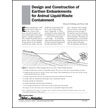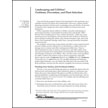Dairy Cattle
2018 Farm Bill Agricultural Commodity Support Programs
This publication reports on the 2018 Farm Bill in order to help agricultural producers in the Pacific Northwest (PNW) navigate its policies and programs, including updates on the dairy, crop and...
A Community-based Response to Flooding, Jay Gordon (Farmer-to-Farmer Case Study Series)
After recent frequent and severe flooding events, dairy farmer Jay Gordon has been working with others in his community to develop a strategy for lessening the impacts of future flooding in their...
Anaerobic digestion offers the dairy and food-processing industries a way to address environmental concerns associated with waste, generate renewable energy, cut bedding-material costs, reduce...
Answers to Common Questions about Greenhouse Gases
Because climate change is one of the most urgent issues of our time, meaningful public discourse about it requires a basic understanding of the types of greenhouse gases (GHGs) involved, where they...
Biofilters in Animal Agriculture
Biofilters can reduce odor emissions from concentrated livestock facilities. This publication discusses what they are and how they work, describes different types and discusses important factors...
Cattle Vaccine Handling and Management Guidelines
Recent research indicates vaccine efficacy is at risk due to improper handling and storage by retailers and livestock producers. Following these guidelines will help ensure effective disease...
Changing Idaho Feed Crop Supply and Demand—Implications
The number of animals in concentrated animal feeding operations has increased since the early 1990s. The upsurge has influenced the supply and demand for crops used as feed, like alfalfa hay,...
Country of Origin Labeling and Livestock Producers
The COOL (country of origin labeling) law is federal regulation that requires any person or entity that supplies a COOL covered commodity to food retailers, such as supermarkets, club warehouses,...
Dairy Ammonia Control Practices
"Rules for the Control of Ammonia from Dairy Farms," established by the Idaho Department of Environmental Quality in 2006, requires Idaho dairy farms that may emit more than 100 tons of ammonia per...
Dairy Compost Production and Use in Idaho: On-Farm Composting Management
This publication describes composting management practices starting from compost material preparation and ending with the evaluation of the finished product. Authors: Lide Chen and Mario deHaro...
Dairy Compost Production and Use in Idaho: The Composting Process
This publication explains what composting is, how it occurs, and how various factors affect it. First in a series on composting dairy wastes in Idaho and using dairy compost on the farm. Authors:...
Dairy Manure Field Applications: How Much is Too Much?
Dairy manure can increase crop yields and improve soil. However, manure can also cause an excess of certain nutrients, which can damage waterways and crops. This publication presents background...
Date, Rate, and Place: The Field Book for Dairy Manure Applicators
This publication provides recording keeping sheets and examples for manure applications on dairy farms. Examples are provided for a number of different manure handling systems. Authors: Andy Bary,...
Dehorn Calves with Paste/Descornar Terneras con Pasta
Of the various methods for dehorning calves that will live in confined areas, dehorning with paste is easy, effective, economical and low stress to the animals. This illustrated sheet covers the...
Design and Construction of Earthen Embankments for Animal Liquid-Waste Containment
Properly designed earthen embankment facilities for animal liquid-waste containment will have adequate storage capacity and be constructed to ensure minimal seepage from the sides and bottom of the...
Double cropping winter forages with corn silage increases total forage available to livestock operations while also removing more phosphorus from the soil. This 13-page bulletin with 14 figures...
Ensiling pressed beet pulp for dairy feed is a relatively new practice in the U.S. This publication summarizes storage alternatives, guidelines for ensiling pressed beet pulp, and tips for...
Estimating Long-Term Idaho Hay Prices Using Multiple Data Sources
The dairy industry can substantially affect markets for other agricultural commodities, particularly those like alfalfa hay, which is used in dairy feed. In other words, hay and milk prices move...
Estimating the Efficiency and Cost of an On-Farm Centrifuge Separator
Cows generate huge amounts of manure annually on Idaho farms, organic waste that demands effective management. Centrifuges offer a more efficient system, though many state producers rely on others,...
Getting Ready for the Fair: Clipping Beef Cattle
Clipping a steer not only helps the animal regulate its temperature more efficiently, it improves its appearance for showtime or auction. But it’s a learned skill that takes a lot of practice. This...
Getting the Most Feed Nutrient for the Dollar
This publication describes a process livestock producers should use to determine the value of a feed that will provide energy or protein to balance a forage-based ration. Authors: Glenn Shewmaker,...
Idaho Environmental/Nutrient Management Program (E/NMP) Basics
Nutrient management is not a game. It verifies the health of your livestock operation and thus requires a documented plan (called an Environmental/Nutrient Management Program), assembled by a...
Inland Pacific Northwest Pasture Calendar
The Inland PNW Pasture Calendar is a comprehensive guide intended to help improve grassland management of forage-livestock systems in the region. From eight chapters and eighteen appendices, learn...
Landscaping and Utilities: Problems, Prevention, and Plant Selection
Without careful planning and plant selection prior to planting, trees and shrubs can become a nuisance and a dangerous and costly problem for homeowners and businesses. This publication has...
Livestock Care for Beginning and Small-Scale Producers
Owning and caring for livestock involves a lot of responsibility and exposes producers to a steep (and fast) learning curve, especially for those just starting out and/or who run small-scale...
Managing Livestock During Wildfire Season
When wildfire season approaches, effective livestock safety and management are crucial and challenging, since dealing with fires often requires flexibility and a rapid response. Learn how to...
Manure and Wastewater Sampling
A review of samples from 42 dairies in Idaho showed that nitrogen (N) and phosphorous (P) in wastewater lagoons vary greatly between farms and from year to year. So manure should be tested as close...
Mitigating High-Phosphorus Soils
According to Idaho law, livestock operators must make sure their operations are not dumping excess phosphorus into the soil, which could then contaminate surface water or groundwater. This...
Odor Control Practices for Northwest Dairies
Large confined dairy cow feeding operations have increased recently in the Pacific Northwest. They produce huge quantities of manure, odors from which can bring conflicts with neighbors. This...
Pasture and Grazing Management in the Northwest
$35 The comprehensive resource for anyone who manages livestock on pastures in the Northwest, this 214-page book offers pasture managers information and tools to enable their pastures and their...
Pregnancy Testing in Beef Cattle
Pregnancy testing in beef cattle is a tool that optimizes heifer management and identifies candidates for culling or removal from the herd. Some methods of pregnancy detection also provide...
Risk Assessment and Decision-Making Guidelines for Dairy Risk Management: Part 1
Dairy farmers, particularly those who run small- and middle-sized enterprises, face significant economic challenges. Financial guidance is more critical than ever. This three-part series addresses...
Risk Assessment and Decision-Making Guidelines for Dairy Risk Management: Part 3
Dairy farmers, particularly those who run small- and middle-sized enterprises, face significant economic challenges. Financial guidance is more critical than ever. This three-part series offers...
Risk Assessment and Decision-Making Guidelines for Dairy Risk Management: Part 2
Dairy farmers, particularly those who run small- and middle-sized enterprises, face significant economic challenges. Financial guidance is more critical than ever. This three-part series offers...
Agricultural odors can be quite problematic for livestock producers, particularly when the neighbors begin to complain. Monitoring these unpleasant smells can help producers to gauge their severity...
Sampling Dairy Manure and Compost for Nutrient Analysis
Testing the nutrient content of dairy manure or compost reveals nutrient value and determines the application rate, but it must be done correctly. This six-page guide shows you how to conduct a...
Spring Annual Forage Hay Production in North-Central Idaho
Cattle producers in north-central Idaho need quality feed for their herds. But to satisfy that need, you need to do your homework. This publication helps growers and cattlemen understand how to use...
The Veterinary Feed Directive: The Why, What and How Guide for Livestock Producers
Since 1996, the Food and Drug Administration (FDA) has taken regulatory action via the Veterinary Feed Directive (VFD) to ensure that drugs used to treat bacterial diseases in all food-producing...












































